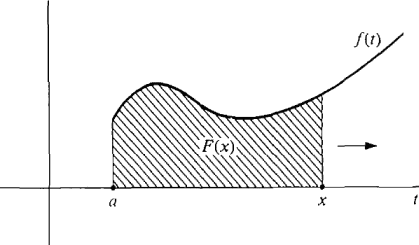| The ebook Elementary Calculus is based on material originally written by H.J. Keisler. For more information please read the copyright pages. |

|

Home  Integral Integral  Theorems of Calculus Theorems of Calculus  Proof of the Fundamental Theorem Proof of the Fundamental Theorem |
|
| See also: Fundamental Theorem of Calculus | |






|
|
Proof of the Fundamental Theorem
We conclude this section with a proof of the Fundamental Theorem of Calculus. PROOF (i) Let f(x) be the area under the curve y = f(t) from a to x,
Imagine that the vertical line cutting the t-axis at x moves to the right as in Figure 4.2.11.
Figure 4.2.11 We show that the rate of change of F(x) is equal to the length f (x) of the moving vertical line. Suppose x increases by an infinitesimal amount ∆x > 0. Then
is the area of an infinitely thin strip of width ∆x and height infinitely close to f(x). By the Rectangle Property the area of the strip is between the inscribed and circumscribed rectangles (Figure 4.2.12), m ∆x ≤ F(x + ∆x) - F(x) ≤ M ∆x.
Figure 4.2.12 Dividing by ∆x,
Since f is continuous at x, the values m and M are both infinitely close to f(x), and therefore
The proof is similar when ∆x < 0. Hence F'(x) = f (x). PROOF (ii) Let F(x) be any antiderivative of f Then, by (i),
In Section 3.7 on curve sketching, we saw that every function with derivative zero is constant. Thus
for some constant C0. Then
so
|
|
Home  Integral Integral  Theorems of Calculus Theorems of Calculus  Proof of the Fundamental Theorem Proof of the Fundamental Theorem |
|
Last Update: 2006-11-05











